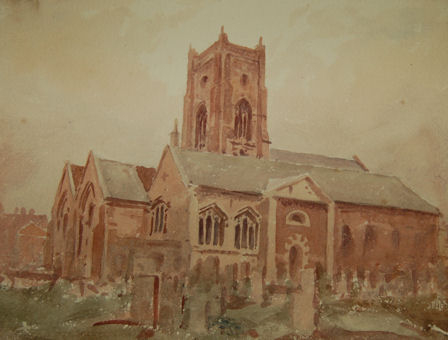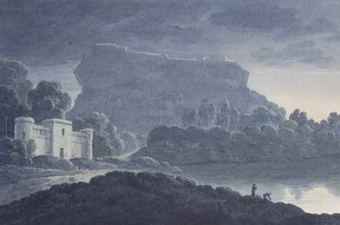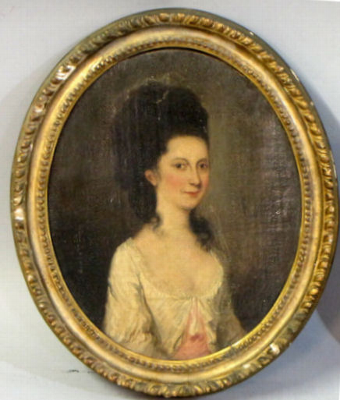Kingston was an important town in Roman days, and no doubt it owed its importance to the fact that its ford provided the first opportunity for the traveller to cross the River Thames. Later this ford was replaced by a wooden bridge which, until Westminster Bridge was built in 1750, was the first bridge over the river above London Bridge. By Saxon times Kingston had become important enough to contain two palaces - one built by the Kings of Wessex in the Bittoms and the other by the Bishops of Winchester between the church and the river. And in 838 A.D, when King Egbert of Wessex, grandfather of Alfred the Great, held his Great Council in Kingston, the town was described in contemporary records as "that famous place called Kingston in Surrey".
The Great Council was attended by the king and his noblemen and by Archbishop Ceolnoth of Canterbury and twenty-four bishops, and at it was made a compact of mutual support and co-operation between church and state. The bishops were given the right to rank in the state as "spiritual lords", a right which they hold to this day and which gives them their seats in the House of Lords.
It is thought that the Great Council was held in a church because one of its acts was apparently made before an altar. Experts have suggested that King Egbert, who had long planned the alliance between church and state and who had seen the great stone church built at Aachen for the coronation of Charlemagne, may have built a new stone church in Kingston, dedicated to All Hallows, to house his Great Council. At the east end of the church there is a fragment of stone with Saxon carving on it. It has been suggested that this may once have formed part of a stone cross which Egbert may have erected to commemorate his Great Council at Kingston.
Sixty-four years later, in 902 A.D, Alfred the Great''s son Edward the Elder came to Kingston to be crowned. He probably chose Kingston, instead of his capital, Winchester, because he wanted to unite the Angles (in Mercia north of the river) with his own Saxons (to the south of it) against the common enemy, the Danes; as the only ford was at Kingston, his coronation there would provide a suitable opportunity for diplomacy after the ceremony. The coronation stone, on which tradition says that Edward the Elder and six of his successors were crowned, is now outside the Guildhall. It is not known exactly where the stone stood in Saxon days, if indeed it existed then, but it is known that part of the coronation ceremony, the prostration of the king before the altar and probably the anointing as well, took place in a church, and it is not unreasonable to assume that this was Egbert''s church of All Hallows.
After Edward the Elder, six Saxon kings were crowned in Kingston; the last was Ethelred II (the "Unready") in 978 A.D. His reign ended in contusion as the Danes intensified their attacks on his kingdom. In 1009 the Danes came up the Thames as far as Staines, burning towns and churches on both sides of the river; it seems impossible that the church in Kingston could have escaped destruction then, if it had not been destroyed earlier. We come now to Norman times, to the reign of the Conqueror''s youngest son, Henry I. In about 1120-30, Gilbert the Norman, Sheriff of Surrey, built a large church in Kingston. This was shaped in the form of a cross, with its tower at the centre. The nave was as long as the present one but was probably without aisles. East of the tower was the chancel and to the north and south of it were two transepts of a depth equal to the present aisles.
Dr. Finny, the Parish Church''s distinguished antiquarian, wrote: "If when Gilbert the Norman built his church in Kingston he did as every Norman builder did who built a cruciform church in Surrey, he rebuilt and re-roofed what remained of the walls of the nave of the Saxon All Hallows'' church and he built his tower on arches on the site of the previous Saxon chancel". When therefore the altar was moved during the recent re-ordering to its present central position under the tower, it was probably placed on or near the site of the old Saxon altar. And the space between the choir stalls may well mark the spot where King Egbert and Archbishop Ceolnoth made their compact at the Great Council of 838, and where seven Saxon kings prostrated themselves at their coronation.
Little or nothing now remains of Gilbert the Norman''s church. Some of the stones in the pillars under the tower may be Norman, and there are some Norman stones (shaped with an axe) where the end nave pillar on the south joins the west wall; these are thought to have formed part of the wall of the old Norman nave. When the Victorians were building the present west porch they uncovered a large Norman doorway cased up in an eighteenth century classical entrance; they photographed it and then unfortunately destroyed it.
The earliest work now visible in the church is the casing of the four tower pillars round the altar, and the tower staircase. This dates from the 13th century and conceals older, Norman, work. In about 1370, the Norman nave was pulled down and a new nave was constructed with aisles. It is probable that the work was spread over a number of years, as the nave pillars, which date from this time, are not all of the same size; those on the north are more slender than those on the south, while the easternmost pillar on the south side is of greater dimensions than its fellows and has no base. It is probable that at this period the opportunity was taken to widen the nave (and probably the chancel also) by some two feet by building the north pillars on to the outside edge of the tower pillar, while those on the south are built on to the centre. Whatever was the reason for doing this, the result, which can clearly be seen today, is that the centre of the nave and chancel does not coincide with the centre of the tower.
During the next century, the 15th, the east end of the church began to take its present shape. During the middle of this century, the chapel on the south, which is now the baptistery, was built and the arcade of three pillars erected. A few years later, the chapel on the north side (now the Memorial Chapel of the East Surrey Regiment) was built for the fraternity of the Holy Trinity.
John Louis Petit was born at Ashton-under-Lyne, Lancashire, son of John Hayes Petit. He was educated at Eton, and contributed to the "Etonian". He was elected to a scholarship at Trinity College Cambridge in 1822, graduated BA in 1823 and MA in 1826, and on 21st June 1850 he was admitted "ad eundem" at Oxford. He took holy orders in 1824, but undertook no parochial work.
Petit showed a taste for sketching in early years. His favourite subject was old churches, and a great part of his life was spent in visiting and sketching them. In 1839 he made his first extensive tour of the continent. The results appeared in his "Remarks on Church Architectire" (1841, 2 vols which had illustratuions. It was followed in 1846 by "Remarks on Church Architectural Character" Royal folio format.In the same year Petit published a lecture which he had delivered on 24th Feb 1846 to the Oxford Society for promoting the study of Gothic Architecture, under the title "Remarks on the Principles of Gothic Architecture as applied to ordinary Parish Churches". It was succeeded by "Architectire of Tewksbury Abbey Church". Royal svo 1846. " Architectural notes in the neighbourhood of Cheltenham"and "Remarks on Wimborne Minster", 1847. "Remarks on Southwell Minster". With numerous good illustrations. 1848. "Architectural Notices relating to Churches in Gloucestershire and Susse". 1849. "Architectural Notices of the Curious Church of Gillingham.Norfolk". And an "Account of Sherborne Minster". 1850. In 1852 Petit published an account of Brinkburn Priory".
In 1854 appeared Petit''s principal work. "Architectural Studies in France", imperial SVO. It was beautifully illustrated with fine woodcuts and facsimiles of anastic drawings by the author and his companion, Professor Delamotte. It showed much learningand observation, and threw light upon the formation of Gothic in France, and on the differences between English and French Gothic. A new edition , revised by Edward Bell, FSA, with introduction, notes and index, appeared in 1890. The text remained unaltered but the illustrations were reduced in size, and a few added from Petit''s unused woodcuts. In 1864-65 he travelled in the East and executed some striking drawings. He died in Lichfield on 2 Dec 1868, from a cold caught while sketching and was buried in St Micheal''s Churchyard. Petit was the founder of the British Archealogical Institute at Cambridge in 1844. He was also FSA, an honoury member of the Institute of British Architects, and a governor of Christ''s hospital.
Antiques.co.uk Ref: 8JCYQWA3
- Materials:
- Pencil and Watercolour
- Width (cm):
- 11 x 15 in. 28 x 38 cm.














